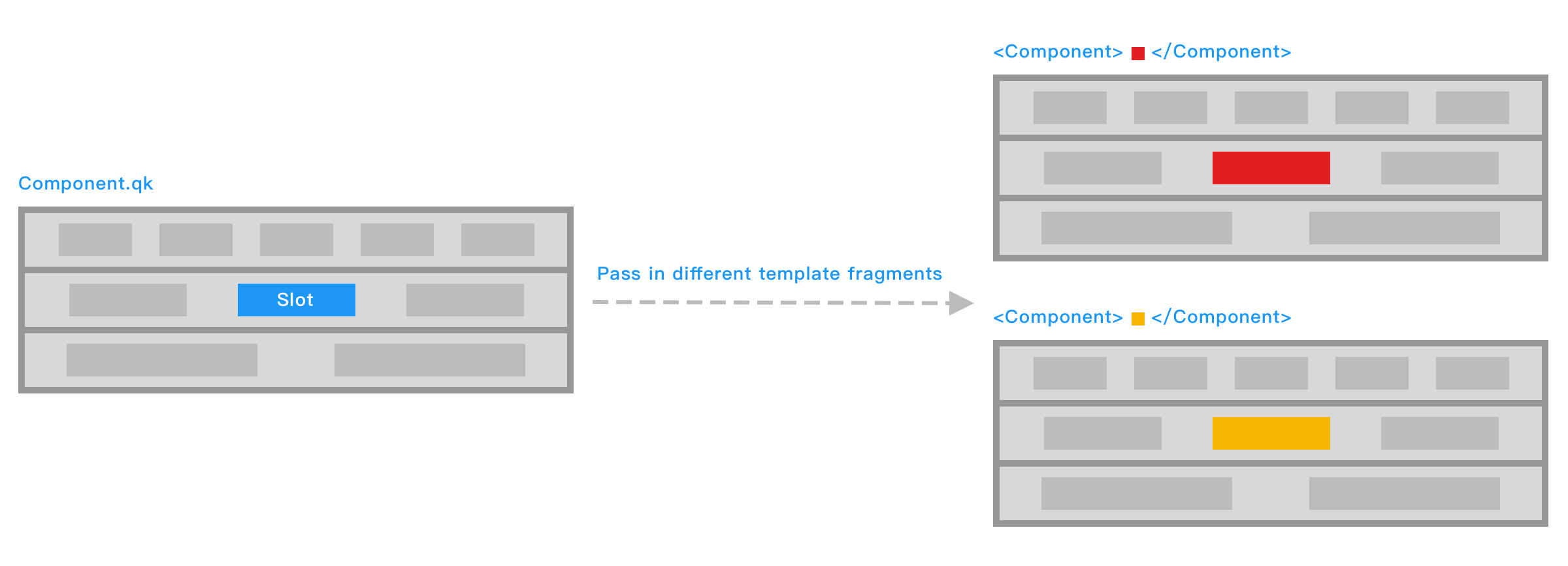Slots
Component slots are used to pass structured UI content (template fragments) to components. Their key difference from attributes lies in the content type they convey: attributes pass data while slots pass interface structures. Through slots, parent components can insert custom DOM content into specified locations of child components, enabling greater flexibility and reusability. This makes slots an essential mechanism for building layout containers, modals, list renderings and other generic components.

Basic Usage
Declare slot positions inside components using the slot tag, which gets replaced by child elements passed when using the component:
<!-- Outter.qk -->
<Inner>...</Inner>
<!-- Inner.qk -->
<div class="inner-box">
<slot></slot>
</div>This renders as:
<div class="inner-box">...</div>Slot templates aren't limited to text - they can contain elements, components, or any valid template content:
<Inner>
<FontIcon name="tip" />
<p #for={3}>...</p>
</Inner>Scope
Slot templates can access data from their component's scope:
<!-- The code of the Inner component is the same as above -->
<lang-js>
const langs = ["js", "ts", "qk"]
</lang-js>
<Inner>
<p #for={item, index of langs}>
{index + 1}/{langs.length}: {item}
</p>
</Inner>This renders as:
<div class="inner-box">
<p>1/3: js</p>
<p>2/3: ts</p>
<p>3/3: qk</p>
</div>Default Content
Child elements inside slot tags serve as default content, rendered when no slot content is provided:
<!-- Outter.qk -->
<Inner />
<!-- Inner.qk -->
<div class="inner-box">
<slot>Default content</slot>
</div>This renders as:
<div class="inner-box">Default content</div>Named Slots
Components often require multiple slots. When a component has several slots, we distinguish them using the name attribute:
<!-- Article.qk -->
<article>
<slot></slot>
</article>
<footer>
<slot name="footer"></slot>
</footer>name attributes default to default.
When using components, specify slot names via the slot attribute:
<Atricle>
<!-- Can be omitted when slot attribute value is "default" -->
<div slot="default">Article contents...</div>
<p slot="footer">Copyright informations...</p>
</Article>For text-only slot content or to avoid extra meaningless tags, use qk:spread as a virtual parent element:
<Article>
<qk:spread>Article contents...</qk:spread>
<qk:spread slot="footer">
<p>Release informations...</p>
<p>Copyright informations...</p>
</qk:spread>
</Article>Context Passing
While our Scope section explained slot content normally only accesses its component's scope data, practical development often requires accessing data from the child component's slot definition side. We expose needed context by adding attributes to the slot tag (these get combined into a context object):
<!-- Article.qk -->
<article>
<slot
!time={article.time}
!title={article.title}
></slot>
</article>he receiving side can use the #slot directive to name and utilize this object:
<Article>
<qk:spread #slot={articleInfo}>
<h1>{articleInfo.title}</h1>
<p>Published in {articleInfo.time}</p>
</qk:spread>
</Article>The #slot directive supports destructuring syntax:
<Article>
<qk:spread
#slot={
{
title,
time: publishedTime
}
}
>
<h1>{title}</h1>
<p>Published in {publishedTime}</p>
</qk:spread>
</Article>